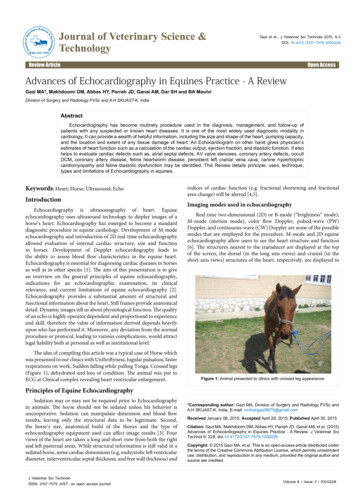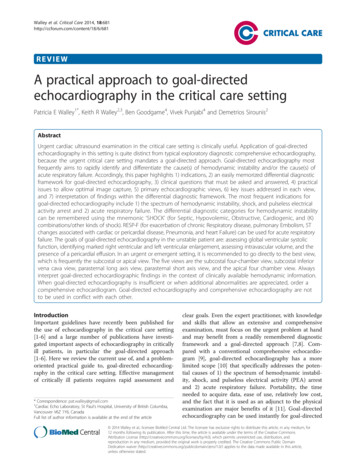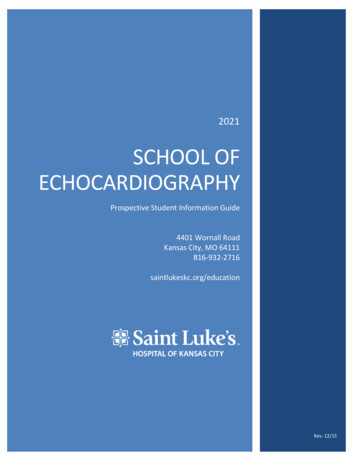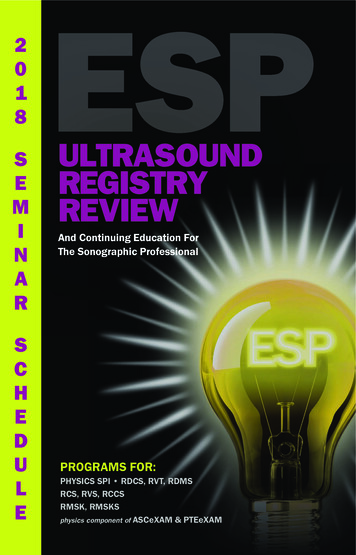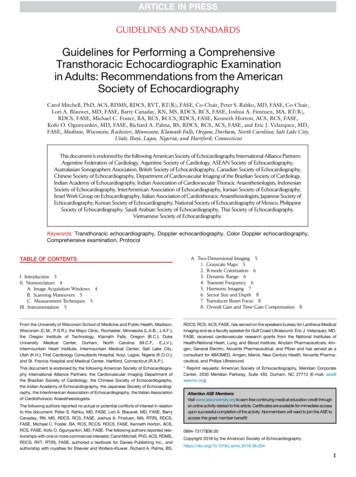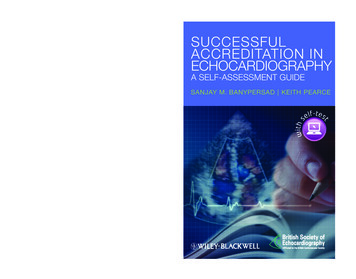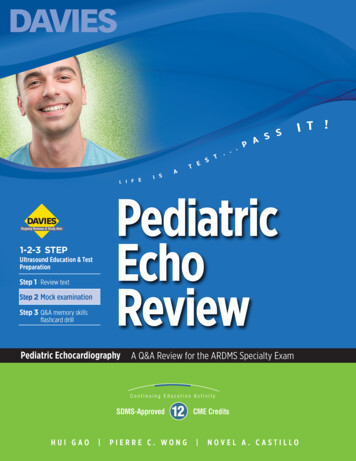
Transcription
NEHOUAPortsmouth NH 10/11/2019Echocardiography : basics andillustrations( Everything you always wanted to know about echocardiography, but were afraidto ask )Dr James KADOUCHVP Medical DirectorSCOR Global Life Americas
Agenda Types of Echocardiography Common Indications for Echocardiography Anatomy (Basics) Reviewing the Report Chamber dimensions Valves LV systolic and diastolic functions LV regional wall motion Right Ventricle function Pulmonary pressure Aortic Root Pericardium2
Types of echocardiography Transthoracic echocardiography ( TTE )- M-mode- 2D- Doppler : Pulse wave, continuous wave, color- Tissue Doppler imaging Transesophageal echocardiography ( TEE ) Stress echocardiography ( SE ) Contrast echocardiography ( CE ) 3D echocardiography 2D strain or 2D speckle tracking3
Main indications of echocardiographyTTECAD, VHD, Cardiomyopathies, Heart failure, Congenital heart diseases, Aorticroot, Pericardium, Prosthetic valves,Tumors, Thrombi, EndocarditisTEETTE non diagnostic, VHD, Aortic root, Prosthetic valves, Thrombi, Endocarditis,Congenital heart diseasesSECAD, Aortic stenosis, HCMCEShunts R-L, PFO, LVEF3DVHD, Heart failure, Congenital heart diseases2D StrainCAD, Heart failure4
Healthy heart valves5
The cardiac pumpRARVLALV6
Echocardiography doppler7
Different views of transthoracic echocardiography4 major windows to explore the heart and theaorta:-Parasternal window : parasternal long andshort axis.-Apical window : 5,4,3 and 2 chambersviews.-Subcostal window : 4 chambers and shortaxis views.-Suprasternal window ; ascending,horizontal and beginning of stal8
Long axis parasternal viewRVAOLVLA9
10
Echocardiography 2D (4 chambers apical view)LVRVRAoLA11
12
Echocardiography13
CHAMBERS DIMENSIONS AND LVEF14
Echocardiography 2D and TM (long axis parasternal view)RVRVIVSAOLVLVLAPW15
Fractional shortening and LVEF in Time Motion modeFS LVED d – LVES dLVED dLVEF LVED vol – LVES volLVED vol16
Linear trend for LVEF as a continuous variable and unadjusted allcause mortalityCurtis JP et al J Am Coll Cardiol 2003;42: 736-74217
Survival in coronary heart disease is related to LVEFEmond M, Mock MB, Davis KB, et al. Circulation 1994; 90:2645.18
SurvivalImportance of LVEF on MR prognosisEFEFEFYearsSource : Enriquez-Sarano, Circulation 1994;90:830-719
Pronostic factors of aortic insufficiencySource : Chaliki. Circulation. 2002; 106: 268720
Recommendations for the echocardiographic assessment of LV sizeand functionEndocardial border enhancementStrain longitudinal global21
LVEF : 2-D Simpson’s biplane method22
Biplane method of discs or Volumes reduction method aka biplaneSimpson’s method23
Shortcomings of 2D LVEF1.Modest reproducibility, as the exact imaging planes are difficult to recapture.As a rule of thumb, 2D LVEF changes of less than 10 percentage points between examinations do notnecessarily represent an actual change in systolic function. This limits the usefulness of 2D LVEF insequential follow-up of patients.2.LVEF depends on good imaging quality for manual or automated tracking of endocardial border.3.Even under optimal imaging conditions, LVEF can be an incomplete or even an incorrect estimate of LVfunction.This is especially true in significant concentric remodeling, hypertrophic cardiomyopathy orsmall cavity size, where there is significant systolic dysfunction with reduced stroke volume despite anormal or supranormal LVEF.4.LVEF is dependent on current loading conditions and can be both over- and underestimated due toloading conditions.An example of this is the reduced preload in severe mitral regurgitation, which may cause increasedLVEF due to significant regurgitation volume. The opposite might be true in severe aortic stenosis andother states with markedly increased afterload.5.Bradycardia may cause an overestimation of LVEF due to increased stroke volume. Inversely, thereduced stroke volume in tachycardia or variable R–R interval of atrial fibrillation may lead to LVEFunderestimation.24
3D Echocardiography25
3 D LV reconstruction volumetry26
Speckle tracking imaging27
Types of strain28
LV contraction in 3 planes : longitudinal, radial, circumferential29
Myocardial strain : measurement of deformation30
Strain rate : rate of strain change31
Longitudinal Strain rate : normal32
Cardio-oncology33
Normal values and severity partition cutoff for 2DE derived LV size,LVEF, LV mass and LA size according to genderSource : Journal of the American Society of Echocardiography January 201534
CAD : LV SEGMENTAL WALL MOTION35
Typical distribution of coronary arteries36
LV segmentation37
Stress Echocardiography Exercise or pharmacologic (dobutamine) Usually supine bicycle ergometer Procedure Rest echocardiogram recordedExercise to maximal capacityMove to supine within seconds before heart rate decreasesRecord exercise echocardiogram within 60 secondsCompare the images for regional wall motion changes Regional Wall abnormalities normal or hyperkinetic - 1Hypokinetic (reduced thickening) - 2akinetic (absent or negligible thickening, e.g. scar) - 3dyskinetic ( moves paradoxically during systole ) – 4Aneurismal myocardium ( remains deformed during diastole ) Fall in EF or increase in LV ESV may indicate L Main or 3V disease38
VALVULAR HEART DISEASES39
ValvesLeft SideMitral and AorticRight sideTricuspid and PulmonaryStenosis – gradient & areaRegurgitation – size of jetBoth/Either – chamberenlargement/hypertrophy40
Doppler echocardiography Doppler permits assessment of motion by using frequency shifts in ultrasound wavesFrequency of returned ultrasound is higher when movement is toward the transducerDoppler can measure the motion of blood or the motion of tissueColor flow imaging displays flow toward the transducer in red and flows away from the transducer inblue, lighter shades depict higher velocities of flow41
Severe mitral regurgitation42
Aortic regurgitation43
Quantification of an aortic valvular disease with Doppler44
Real time 3D imaging: High Volume Rate45
Transesophageal 3D : normal mitral valve46
DIASTOLIC FUNCTION47
Pulsed Doppler of Mitral Inflow E/A ratio (N .8 – 1.5) USU 1 Isovolumetric relaxation time (IVRT)Atrial contraction (N 70-90 ms) Diastolic deceleration time (DDT) or DT (N 160-240 ms)Aortic valve closureAortic valve opensMitral valve opensUpToDate48
TDI of septal and lateral mitral annular velocitiese’a’49
Evaluation of diastolic function with preserved LVEF(J Am Soc Echocardiogr 2016;29:277-314.)50
Evaluation of diastolic function with depressed LVEFand/or DT 150 msec(J Am Soc Echocardiogr 2016;29:277-314.)51
LV MASS AND LVH52
Is there a secondary cause?- Hypertension,- Aortic or mitral lesionIs it symmetric?Relative wall thickness h/r 0.42 0.42Left Ventricular HypertrophyEcho: measured during diastole- Intraventricular septum ( IVSd )- Posterior Wall ( LVPWd ) 95 ( F ) 95 ( F ) 115 ( M ) 115 ( M )Left ventricular mass index ( g/m² )Septal/posterior wall thickness should be 1.4Otherwise consider asymmetric septal hypertrophy (type of HCM)53
Normal ranges for LV Mass indicesJ Am Soc Echocardiogr 2015;28:1-39.54
LVHConsider the diagnosis of Hypertrophic Cardiomyopathy if LV wall thickness 15mm, without obvious cause (Athlete’s Heart, HBP, valve disorder, etc.), or if thereis a history of syncope, arrhythmia, family history of sudden death or heart failure,or a strain pattern (ST depression and T Wave inversion) on the ECG.The hypertrophy is asymmetric (septal/posterior wall thickness 1.4) orconcentric or apical.55
Hypertrophic obstructive cardiomyopathy56
PULMONARY ARTERY SYSTOLIC PRESSURE ( PASP )57
Estimating Pulmonary Artery systolic pressure (PASP)Echocardiography uses Doppler ultrasound to estimate the pulmonary artery systolic pressure.The maximum tricuspid regurgitant jet velocity (TRV) is recorded and the right atrial pressure (RAP) is estimated from thesize and variation of flow in the inferior vena Cava.The pulmonary artery systolic pressure (PASP) is then calculated using simplified Bernoulli equation :RVSP (4 x [TRV]2) RAPIn the absence of a gradient across the pulmonic valve or RVOT, PASP RVSP58
Estimation of RA pressure on the basis of IVC diameter and collapse(J Am Soc Echocardiogr 2010;23:685-713.)59
Pulmonary artery systolic pressure estimates in normal subjectsCirculation. 2001;104:2797-280260
Regional Assessment of RV Systolic Function TAPSE (Tricuspid annular plane systolic excursion ) or TAM (Tricuspid Annular Motion ). The systolic movement ofthe base of the RV free wall provides one of the most visibly obvious movements on normal echocardiography :method to measure the distance of systolic excursion of the RV annular segment along its longitudinal plane, froma standard apical 4-chamber window.A TAPSE cutoff value 17 mm yielded high specificity, though low sensitivity todistinguish abnormal from normal subjects61
AORTIC ROOT62
Aortic Root1.2.3.4.Aortic valve annulusThe sinuses of ValsalvaThe sino-tubular junctionThe proximal ascending aortaJ Am Soc Echocardiogr 2015;28:1-39.63
Aortic root dimensionsJ Am Soc Echocardiogr 2015;28:1-39.64
Risk of complications ( rupture, dissection, death ) by aorticdiameter and 03.003.20Low risk (1% /y)Moderate risk (8% /y)Severe risk (20% /y).65
Indications for surgery in aortic root disease ( whatever the severity ofAR )European Heart Journal 201266
PERICARDIUM67
Pericardial effusion68
Things I routinely check on the Echocardiogram report Interpretation Ejection Fraction (EF) : Simpson’s method Chamber sizes LAVI or diameter of LA LV dimensions in diastole and systole Wall thickness (IVSd, LVPWd) RV dimensions Valve gradients, area if stenosis, and/or regurgitant jets (if abnormal) LV mass E/A ratio E/e’ if abnormal RVSP69
THANK YOU !70
Echocardiography uses Doppler ultrasound to estimate the pulmonary artery systolic pressure. The maximum tricuspid regurgitant jet velocity (TRV) is recorded and the right atrial pressure (RAP) is estimated from
